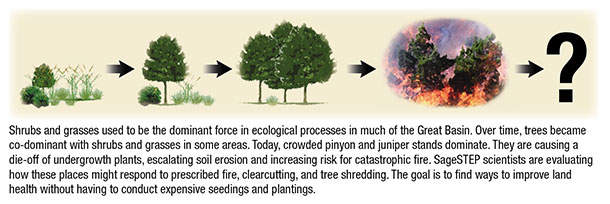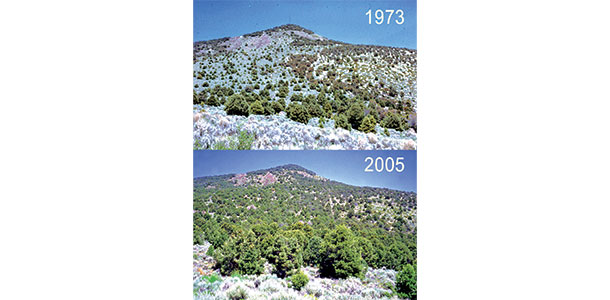Since the settlement of the American West, pinyon and juniper trees have expanded across Utah’s Great Basin, crowding out native bunchgrasses and shrubs. Landscapes that were once high-desert prairies are now thick with thirsty trees.
Bunchgrasses and shrubs have become parched in competition with the trees for soil water.
 Areas that were once scrubbed of their scattered wood by periodic low-intensity fires now burn with blistering wildfires that sterilize the soil and wipe out surviving perennial grasses.
Areas that were once scrubbed of their scattered wood by periodic low-intensity fires now burn with blistering wildfires that sterilize the soil and wipe out surviving perennial grasses.
These changes have reduced forage, diverted soil water, promoted soil loss, and changed wildlife habitat.
There are a lot of unknown factors about how to best improve the health of these lands and to get public support for doing so.
In 2006, SageSTEP scientists and their manager partners began evaluating how plant communities that had been encroached on by pinyon and juniper might respond to prescribed fire, clear-cutting and mastication (tree shredding) and if the people who cared about these lands could support these treatments.
The goal was to find ways to improve land health without having to conduct expensive seedings and plantings.
Ways to reduce trees
SageSTEP scientists looked at several methods for curtailing pinyon and juniper expansion and considered how these methods would trickle through the ecosystem. Prescribed fire is one technique that can be an ecologically (and economically) useful way to restore native perennial bunchgrasses.
In cooperation with SageSTEP scientists, managers blackened 60 to 90 percent of the ground in test sites, reducing tree cover to less than 5 percent of original cover.
 These prescribed burns were done in a way to mimic natural fire. Of the three treatments studied, prescribed fire seemed to stick it to the trees best over time. After two years, areas treated with prescribed fire also had lower shrub biomass than areas treated mechanically.
These prescribed burns were done in a way to mimic natural fire. Of the three treatments studied, prescribed fire seemed to stick it to the trees best over time. After two years, areas treated with prescribed fire also had lower shrub biomass than areas treated mechanically.
But all treatments were generally effective in reducing tree cover, and mechanical treatments had alternative benefits.
Mastication, or tree shredding, involved less risk than prescribed fire. It could be used as a thinning or clear-cutting tool and could be performed as long as the soil wasn’t too wet.
Soil compaction from the mastication machines can occur in the short term, but the mulch produced can also increase water infiltration between plants and shrubs.
Clear-cutting in this study involved using chainsaws to cut trees taller than a half-meter and leaving them where they fell. Both mastication and clear-cutting reduced tree cover to less than 1 percent of what it was before treatment.
But any action on public land needs support from people who care about these places. In our survey of residents of the Great Basin, the people who accepted these practices also had limited trust in a land management agency’s ability to implement the practice.
If they didn’t trust the agency, they were more likely to reject the restoration practice.
This suggests that efforts to increase acceptance of prescribed burning or tree shredding should focus on building trust in the manager rather than simply providing more or better information about the treatment.
Change trickles through the system
Removing trees by mechanical methods and prescribed fire set into motion a cascade of changes in the ecosystem, beginning with soil water.
Removing trees increased springtime water in the soil by up to 26 days. The largest increases in soil water were seen in older stands, where closely packed trees had used most of the water before treatment.
Woodlands that had enough native grasses and plants to take advantage of this water after tree removal saw an increase in these plants.
Sites without a good population of native or desirable plants became at risk for invasion from opportunistic plant species like cheatgrass.
Pinyon and juniper trees steal water from plants, causing undergrowth to die off. Without grasses and forbs to hold soil in place, sloped ground is at risk for soil erosion and runoff.
When the amount of bare ground on a slope is greater than 50 percent, erosion increases exponentially. If ignored, tree-encroached sagebrush steppe has a substantial risk of soil loss, especially during high-intensity summer storms.
But burning has its own problems in the short term. When we burned trees on hill slopes, those areas shed substantially more sediment than unburned areas during rainstorms.
Mechanical treatments were better at reducing short-term erosion. Chips from shredded trees allowed water to soak into the ground, helping reduce erosion.
The serious consequences of severe wildfire from crowded woodlands and the ecological consequence of undergrowth die-off pose long-term problems.
Prescribed fire-burned woodlands are vulnerable to rain in the short term, but removing trees can trigger vegetation to reclaim the site, creating a rosier outlook for its long-term health.
Vegetation
Fire had very different effects on vegetation than did cutting. Cutting had no effect on shrubs, while fire reduced shrubs to about one-tenth of what they were.
Fire also increased bare ground for a few years and decreased the cover of tall perennial grasses and biological soil crusts. By the third growing season after fire and mechanical treatments, both perennial grasses and shrubs began to fill in some of the bare ground.
Most herbaceous vegetation – perennial grasses, perennial forbs and non-native plants – increased significantly after fire or mechanical treatments; only biological soil crusts remained at reduced levels three years after the trees were removed.
Cheatgrass
Even where initial native plant levels were as low as 8 to 10 percent before trees were removed, we saw a steady recovery of the herbaceous perennial plants afterward. It isn’t clear yet if these plants will be able to continue capturing the newly available water resource in coming years, or if cheatgrass will take up that additional water.
We do know that burning increased cheatgrass cover even in less tree-crowded woodlands, and because the native vegetation did not respond as well, the balance tipped slightly in favor of cheatgrass at these sites.
To best avoid weed dominance, the problem should be tackled before tree cover exceeds 40 percent. But if trees are shredded at higher cover, seeding can increase desirable plants and discourage weed dominance.
Wildfire potential
We wanted to shift wildfires from occasional big ones that sterilize the soil to smaller, cooler fires that clean out woody debris but allow perennial bunchgrasses to return.
To do this, we needed to decrease wood on the ground. In younger, less crowded stands, prescribed fire consumed enough wood to decrease fuel on the ground.
In older stands with more trees, the amount of burnable wood on the ground either did not change or increased after the burn, probably because the fire killed trees.
The removal of trees allowed more soil water to be used by grasses and forbs as they grew to reclaim the site.
Prescribed fire removed live trees and consumed much of the downed wood, leading wildfire to be less intense and less severe. Prescribed fire would prevent wildfires from having more severe effects on soils, seed banks and vegetation.
Tree mastication and clear-cutting had nearly the opposite effect in the short term, typically doubling or tripling small downed wood as trees were shredded or cut, particularly in older stands.
Mastication caused wildfires to be less intense but more severe. In these areas, wildfire smoldered in wood chips left behind from mastication and wood downed by cutting, which heated the soil, killing microbes and seeds, changing soil chemistry and killing the roots of the grasses and forbs that managed to survive the fire.
With this study, we’ve begun to answer some important questions about how pinyon- and juniper-encroached lands will respond to prescribed fire and mechanical treatments, but important questions remain.
SageSTEP scientists will continue to monitor the treated sites, providing a clearer picture of the slow-moving changes that happen in these big ecosystems. ![]()
See SageStep Treatment Evaluation Project for more information about what happens to fuels, soils and vegetation after shredding or burning pinyon and juniper.
PHOTOS
PHOTO 1: Shrubs and grasses used to be the dominant force in ecological processes in much of the Great Basin.
PHOTO 2: These time-lapse photos show the extent of juniper encroachment over time in the Shoshone Mountains of Nevada. Photos by R. Tausch.







